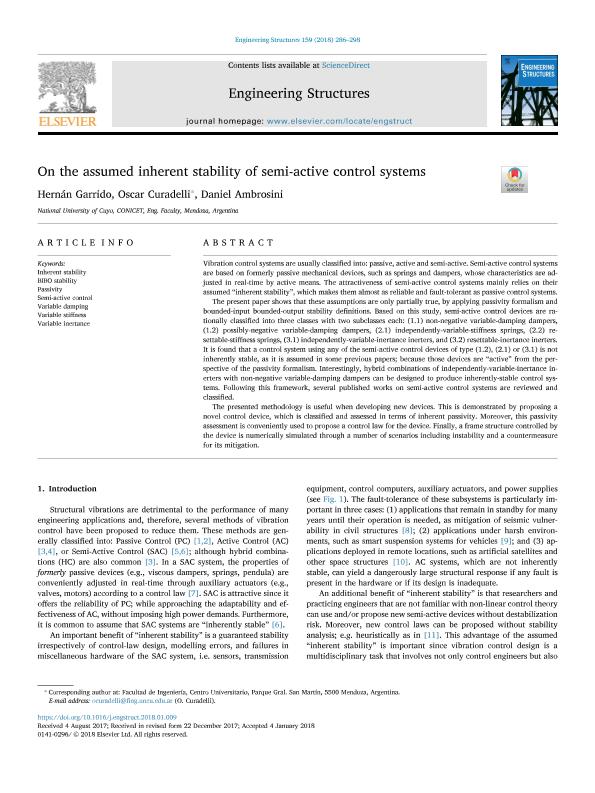Artículo
On the assumed inherent stability of semi-active control systems
Fecha de publicación:
03/2018
Editorial:
Elsevier
Revista:
Engineering Structures
ISSN:
0141-0296
Idioma:
Inglés
Tipo de recurso:
Artículo publicado
Clasificación temática:
Resumen
Vibration control systems are usually classified into: passive, active and semi-active. Semi-active control systems are based on formerly passive mechanical devices, such as springs and dampers, whose characteristics are adjusted in real-time by active means. The attractiveness of semi-active control systems mainly relies on their assumed “inherent stability”, which makes them almost as reliable and fault-tolerant as passive control systems. The present paper shows that these assumptions are only partially true, by applying passivity formalism and bounded-input bounded-output stability definitions. Based on this study, semi-active control devices are rationally classified into three classes with two subclasses each: (1.1) non-negative variable-damping dampers, (1.2) possibly-negative variable-damping dampers, (2.1) independently-variable-stiffness springs, (2.2) resettable-stiffness springs, (3.1) independently-variable-inertance inerters, and (3.2) resettable-inertance inerters. It is found that a control system using any of the semi-active control devices of type (1.2), (2.1) or (3.1) is not inherently stable, as it is assumed in some previous papers; because those devices are “active” from the perspective of the passivity formalism. Interestingly, hybrid combinations of independently-variable-inertance inerters with non-negative variable-damping dampers can be designed to produce inherently-stable control systems. Following this framework, several published works on semi-active control systems are reviewed and classified. The presented methodology is useful when developing new devices. This is demonstrated by proposing a novel control device, which is classified and assessed in terms of inherent passivity. Moreover, this passivity assessment is conveniently used to propose a control law for the device. Finally, a frame structure controlled by the device is numerically simulated through a number of scenarios including instability and a countermeasure for its mitigation.
Archivos asociados
Licencia
Identificadores
Colecciones
Articulos(CCT - MENDOZA)
Articulos de CTRO.CIENTIFICO TECNOL.CONICET - MENDOZA
Articulos de CTRO.CIENTIFICO TECNOL.CONICET - MENDOZA
Citación
Garrido, Carlos Hernán; Curadelli, Raul Oscar; Ambrosini, Ricardo Daniel; On the assumed inherent stability of semi-active control systems; Elsevier; Engineering Structures; 159; 3-2018; 286-298
Compartir
Altmétricas




